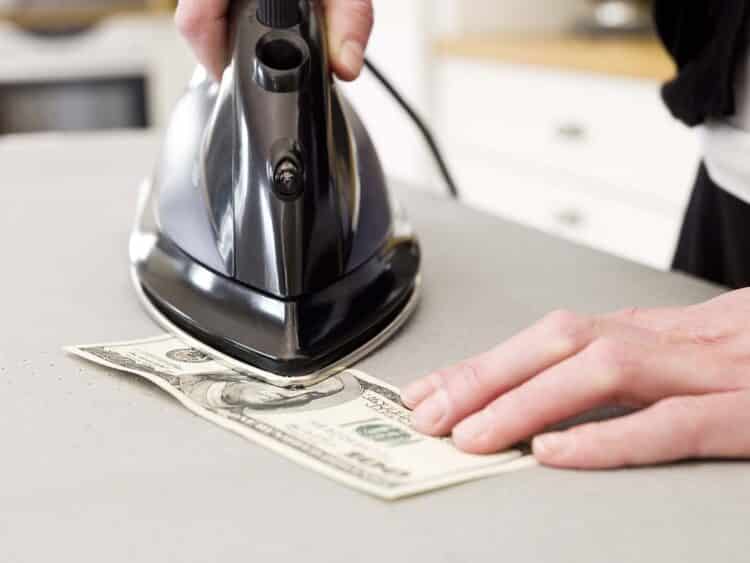It takes time, effort, and money to build a currency collection. When you find an outstanding bill with creases and folds, the price tends to be relatively good.
Although you might not get a high grade for your bill, a little ironing can improve its presentation.
When you get creased or crumpled bills, the money can be restored to a flat, crisp condition with an iron and a few techniques. This work must be done correctly to ensure the bill doesn’t receive more damage.
How to Iron Money to Help Your Bills Looking Crisp and New
Paper currency issued in the United States provides a blend of 75/25 cotton and linen. That combination gives it a unique texture that feels strong and stable in your hand. Other countries have started using plastic fibers. If a linen-based bill is wrinkled, it can be sprayed and ironed to become flat and crisp.
When you receive a unique bill, the first step should be to sanitize the paper while removing mild films or stains from its surface. This outcome is achievable by using one or more of the following methods.
1. Use Carbon Dioxide
Carbon dioxide helps the phosphorescent ink and holograms on US bills stay intact. This technique also preserves the composition, which is crucial for collectors who want to sell their bills at a later time.
Many people pay generously for rare, discontinued, or old banknotes. You’ll get more when the product is in the proper condition or shows no signs of tampering.
The disadvantage of using carbon dioxide cleaners is that the product can remove the top film on the note that the mint leaves after printing. If that happens, the value of that item can drop significantly.
Four techniques are possible when using this option for cleaning with carbon dioxide.
- Liquid Carbon Dioxide Washing. Liquid systems take a low-pressure cylinder that strips contaminants from the paper-linen combination. Surfactants can get added to the process to ensure the bills get a great scrub.
- Supercritical Options. SFCO2 systems use carbon dioxide’s solvent properties to create a cleaning experience. It’s suitable for delicate parts, but could be problematic when trying to wash bills.
- Snow Cleaning. This technique can remove particles as small as three nanometers from a problematic banknote. It also eliminates organic residues, but can cause ink fading or discoloration.
- Pellet Systems. With this cleaning option, dry ice pieces work to remove contamination. These products are typically meant for industrial use, and they would be too forceful to safely improve today’s currency.
The safest carbon dioxide cleaners are typically the ones meant to remove pet odors from carpeting. Try to avoid anything meant to clean a carburetor because these products are usually too strong.
Even air canisters could be too forceful when trying to remove gentle debris. Unless you’re experienced with using CO2 for cleaning, my recommendation is to allow a professional restorer to improve your currency instead of trying to do the work yourself.
2. Wash in the Sink
If your paper currency is fragile, unique, or very old, this method is the best choice to use for improving banknotes. You don’t need to use a sink to have a successful experience. As long as you have a small pan or container available, this option allows you to rub the dirt away.
Run warm, but not hot water into the sink. Add a small drop or two of mild liquid dish soap.
Swish the water around until you’ve formed a soapy solution for washing the bills. Once you get some nice suds, start lightly rubbing small circles over the note for up to ten minutes. Rinse the money in the warm water with soap, then use clean water to eliminate any lingering residue.
Hang the cleaned bills to dry until they feel damp. Once you’ve reached this stage, they’re ready to iron so that you can remove the different creases and folds.
3. Use the Washing Machine
Most money accumulates things you don’t want your hands touching as time passes. Circulated bills can have significant skin oils, bacteria, dirt, and stains. If you iron banknotes with these issues, the heat could cause them to become semi-permanent or worse.
Don’t stick the bills directly into the machine without any protection. You can use a soft cloth pouch, a pinned sock, or a lingerie bag to protect the currency while it gets washed.
Only use a small amount of mild laundry detergent when using this method. Use the delicate cycle (or whatever the gentle wash setting is on your equipment), checking periodically to ensure that the money remains intact.
How to Iron Your Money to Remove Marks
When you start ironing your banknotes, it is crucial for the equipment to be on an appropriate setting. Look for the dial or knob to offer a “rayon” or a “silk” option to get the best results. You should also have the steam press activated.
Place the currency on an ironing board as you smooth the notes. The Bartnelli Rorets Ironing Board is an excellent choice because it provides a soft cloth surface while offering a compact shape to use. The cover pad delivers four layers of support for this project.
After placing the bill on the ironing board, put a soft towel on top of the banknote to protect the paper-linen combination from tearing or burning while working to improve it. If you iron currency with dry heat, it can flame with surprising speed.
Once the iron reaches the expected temperature, place it on the banknotes you’re working to improve. Try to use a circular motion on top with gentle pressure.
If you iron the currency at a higher setting, it typically creates a burnished look. Aging can look great for a personal collection, but it can also ruin the value of what you have.
Once the banknotes are pressed, they need to air dry to achieve the crispness you want with the currency. After you reach that stage, you can frame each piece or add them to your collection in other ways.
What Is the Best Iron for Ironing Money?
When I need to improve my currency collection condition, I turn to the PurSteam Professional Grade Steam Iron.
You need to be careful when using this iron at home. Since it uses 1700W (more than a microwave), you can overload some household circuits. After you’ve spent so much time washing your money to remove the wrinkles, it isn’t fun to run to flip the breaker switch!
This iron offers excellent balance and control while providing a lightweight user profile. You can select how much steam is needed based on the fabric type, making it a versatile addition to your home.
Once you’ve finished improving your money, you can handle those starched collars or wrinkled shirts.
Choosing this PurSteam iron for your regular laundry duties cuts your chore time in half. You’ll find that it gently glides across the towel with your money underneath while delivering an ideal temperature.
The iron features an automatic three-way shutdown system that avoids burnt clothing and possible accidents. When combined with the anti-drip design, you won’t need to worry about fluids coming from the soleplate when this tool isn’t in use.
It provides a larger water tank than most models, visible fluid levels, and a ready indicator so that you know there’s enough heat available without putting your hand close to the soleplate.
Although plenty of irons can get the job done with a deft hand, the PurSteam Professional Grade Steam Iron stands out for all the right reasons. It’s worth adding to your tool collection if you love finding and improving old currency.
How to Remove Wrinkles from Bills Without Washing Them
Some collectors prefer to avoid washing their paper notes because of the damage risks associated with those actions. If you want to get rid of creases and wrinkles from folding, you can dampen the currency instead of choosing one of the three cleaning methods.
A spray bottle is helpful for this process, but you can use your hands to sprinkle a bit of water on the bill.
Once the water gets onto the paper-linen material, you can start flattening the wrinkles. Gently press the currency into a soft surface to avoid tearing, moving from top to bottom vertically and horizontally to achieve the best results.
Repeat as needed until you see the unwanted creases start fading.
After you’ve taken steps to moisten and flatten the bill, allow it to hang as the air-drying process works. Instead of using laundry clothes pins for this step, a simple paper clip will achieve your desired results without risking a potential stain.
You can also lay the bill flat to dry. This option can cause the edges to curl a little, which is why ironing is often recommended.
What Countries Have Polymer Money?
Over 20 countries currently use polymers to produce banknotes. In 1988, Australia was the first to issue currency with this material. Canada, Romania, Vietnam, New Zealand, Fiji, and others have taken this step because issuing three billion banknotes is equal to driving a car around the planet over 9,000 times.
I prefer to collect paper money, even though the polymer options are more colorful, because of how the linen makes the bills feel. Although the lifespan is shorter with banknotes like those issued by the United States, knowing how to iron money can preserve its qualities.
Don’t make the mistake I did of practicing on a high-value note first. Find a folded, creased, and crumpled $1 bill to work on your technique.
I tried to improve a $20 star bill, and that work ended in a disaster. The ink literally stuck to the bottom of the towel because I didn’t realize the heat setting was too high.
Before you plug in your iron, try to do all the washing work first. It’ll help the process be more efficient as you work to remove those wrinkles. With a gentle touch and a little practice, you can collect almost any paper currency and improve its appearance with this simple technique.


